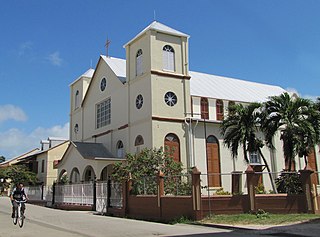
A parish is a territorial entity in many Christian denominations, constituting a division within a diocese. A parish is under the pastoral care and clerical jurisdiction of a priest, often termed a parish priest, who might be assisted by one or more curates, and who operates from a parish church. Historically, a parish often covered the same geographical area as a manor. Its association with the parish church remains paramount.

An altar is a table or platform for the presentation of religious offerings, for sacrifices, or for other ritualistic purposes. Altars are found at shrines, temples, churches, and other places of worship. They are used particularly in paganism, Christianity, Buddhism, Hinduism, Judaism, modern paganism, and in certain Islamic communities around Caucasia and Asia Minor. Many historical-medieval faiths also made use of them, including the Roman, Greek, and Norse religions.

The Free Church of England (FCE) is an episcopal church based in England. The church was founded when a number of congregations separated from the established Church of England in the middle of the 19th century.

An altar server is a lay assistant to a member of the clergy during a Christian liturgy. An altar server attends to supporting tasks at the altar such as fetching and carrying, ringing the altar bell, helping bring up the gifts, and bringing up the liturgical books, among other things. If young, the server is commonly called an altar boy or altar girl. In some Christian denominations, altar servers are known as acolytes.

The Anglican ministry is both the leadership and agency of Christian service in the Anglican Communion. Ministry commonly refers to the office of ordained clergy: the threefold order of bishops, priests and deacons. More accurately, Anglican ministry includes many laypeople who devote themselves to the ministry of the church, either individually or in lower/assisting offices such as lector, acolyte, sub-deacon, Eucharistic minister, cantor, musicians, parish secretary or assistant, warden, vestry member, etc. Ultimately, all baptized members of the church are considered to partake in the ministry of the Body of Christ.

St. Peter's Cathedral, Charlottetown, Prince Edward Island, Canada, was founded in 1869 as a result of the influence of the Oxford Movement. Since that time, the parish has remained Anglo-Catholic in ethos and practice.
The Anglican realignment is a movement among some Anglicans to align themselves under new or alternative oversight within or outside the Anglican Communion. This movement is primarily active in parts of the Episcopal Church in the United States and the Anglican Church of Canada. Two of the major events that contributed to the movement were the 2002 decision of the Diocese of New Westminster in Canada to authorise a rite of blessing for same-sex unions, and the nomination of two openly gay priests in 2003 to become bishops. Jeffrey John, an openly gay priest with a long-time partner, was appointed to be the next Bishop of Reading in the Church of England and the General Convention of the Episcopal Church ratified the election of Gene Robinson, an openly gay non-celibate man, as Bishop of New Hampshire. Jeffrey John ultimately declined the appointment due to pressure.
The Communion of Evangelical Episcopal Churches (CEEC) is a Christian convergence communion established in 1995 within the United States of America. With a large international presence in six provinces and seven U.S. dioceses, most of its churches and missions are spread throughout the Mid-Atlantic and Mid-West regions, and South Carolina; Florida and California; and India. The Communion of Evangelical Episcopal Churches is currently led by Bishop Quintin Moore as presiding bishop of the CEEC.

The Anglican Church in North America (ACNA) is a Christian denomination in the Anglican tradition in the United States and Canada. It also includes ten congregations in Mexico, two mission churches in Guatemala, and a missionary diocese in Cuba. Headquartered in Ambridge, Pennsylvania, the church reported 977 congregations and 124,999 members in 2022. The first archbishop of the ACNA was Robert Duncan, who was succeeded by Foley Beach in 2014.
The Diocese of Cyprus and the Gulf is one of four dioceses in the Episcopal Church in Jerusalem and the Middle East, a province in the Anglican Communion. It covers Cyprus and the Arabian Peninsula, Iraq and Yemen. The bishop in Cyprus and the Gulf is the Ordinary of the diocese. In every part of the diocese, except in Cyprus and Iraq, the congregations are largely expatriate, with many Christians from Pakistan, India, Sri Lanka, the Philippines and the African continent. The diocese is linked with the Diocese of Exeter in England and the Diocese of Thika in Kenya. The diocese is divided into the Archdeaconry of Cyprus and the Archdeaconry of the Gulf: Christopher Futcher was collated archdeacon in Cyprus on 7 September 2019. The Rev'd Canon Dr. Michael Mbona, a Zimbabwean serving at St. Paul's in Kuwait, was appointed as Archdeacon for the Gulf, following the retirement of long-serving Archdeacon Bill Schwartz, OBE.

The Anglican Catholic Church in Australia (ACCA) is the regional jurisdiction of the Traditional Anglican Church for Australia. The ACCA is not affiliated with the Missionary Diocese of Australia & New Zealand of the Anglican Catholic Church.

The development of the ministry of altar server has a long history. In the early Church, many ministries were held by men and women. By the early Middle Ages, some of these ministries were formalized under the term "minor orders" and used as steps to priestly ordination. One of the minor orders was the office of acolyte. Altar servers are a substitute for an instituted acolyte.
A personal ordinariate for former Anglicans, shortened as personal ordinariate or Anglican ordinariate, is an ordinariate, a canonical structure within the Catholic Church established in order to enable "groups of Anglicans" and Methodists to join the Catholic Church while preserving elements of their liturgical and spiritual patrimony.

St. Stephen's Anglican Church is a historic stone church located at 45 Donaldson Road in the Buckingham sector of Gatineau, Quebec, Canada. First organized as a congregation in 1845, St. Stephen's counts itself among the oldest anglophone churches in West Quebec.

The Personal Ordinariate of the Chair of Saint Peter is a Latin Church ecclesiastical jurisdiction or personal ordinariate of the Catholic Church for Anglican converts in the United States and Canada. It allows these parishioners to maintain elements of Anglican liturgy and tradition in their services. The ordinariate was established by the Vatican in 2012.
St Peter's Church is a Church of Ireland parish church in Belfast, Northern Ireland. The building is the centre of worship for the Anglican community based on or around the Antrim Road within the city limits.
Osmond Peter Martin, served from 1983 to 2006 as the third bishop of the Catholic Church for the Roman Catholic Diocese of Belize City-Belmopan.

This history of the Catholic church in Belize has three parts: the historical periods of the Catholic presence in Belize, religious congregations laboring in Belize, and apostolic works undertaken.

St John the Baptist Anglican Church is a heritage-listed church at Crawford Street, Richmond, Shire of Richmond, Queensland, Australia. It was built in 1909 by Mr Moore of Hughenden. It was added to the Queensland Heritage Register on 25 February 2000.

St. John's Cathedral is the cathedral of the Thoothukudi - Nazareth Diocese of the Church of South India.















